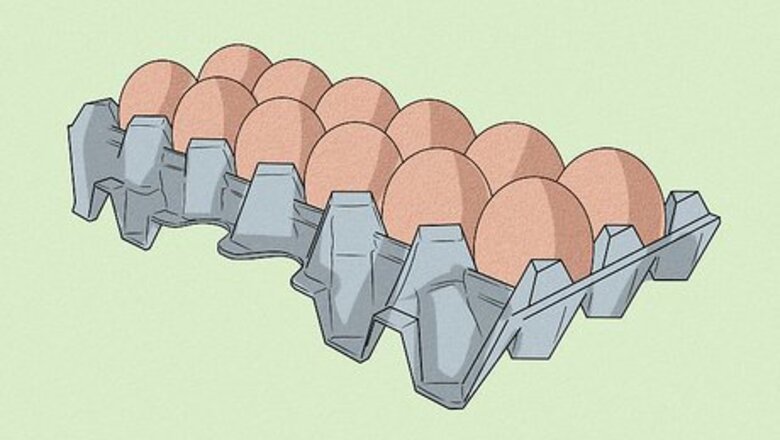
views
Using the Standard Technique
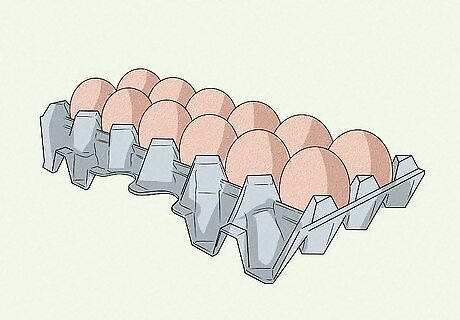
Use fresh eggs. As a general rule, relatively fresh eggs are safer to use than old eggs. Do not use an egg that is past its expiration date and never use an egg that has any cracks in the shell.
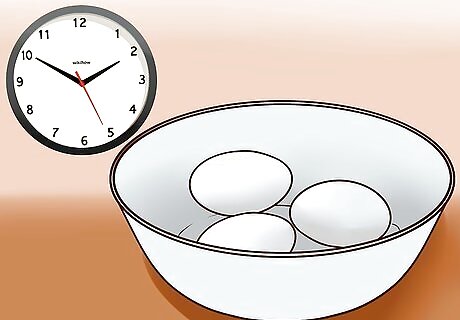
Bring the eggs to room temperature. Take the eggs you plan on using out of the refrigerator and let them sit out on your kitchen counter for 15 to 20 minutes. The shell of each egg should feel close to room temperature before you proceed any further. Do not use chilled eggs for this procedure. The egg yolks need to reach a temperature of 59 degrees Celsius (138 degrees Fahrenheit) before potential bacteria will die, but cold eggs may not warm up sufficiently during the limited amount of time they can spend in the warm water used for pasteurizing. Room temperature eggs, on the other hand, have a better chance.
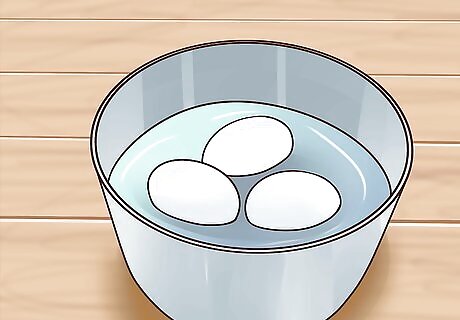
Place the eggs in a saucepan of water. Fill a small saucepan halfway with cool to cold water. Carefully place the eggs inside the water, laying them on the bottom of the saucepan in a single layer. If necessary, add more water to the saucepan after placing the eggs inside. The eggs should be covered by about 2.5 cm (1 inch) of water. Attach an instant-read thermometer to the side of the pan. Make sure that the tip of the thermometer rests underneath the water so that it can read the temperature of the water throughout the process. You will need to monitor the temperature very closely. Note that any instant-read thermometer will work, but a digital thermometer is probably your best bet since it allows you to read temperature fluctuations more precisely.

Slowly heat the water. Place the saucepan on the stove and heat it using a medium heat setting. Allow the water to reach a temperature of 60 degrees Celsius (140 degrees Fahrenheit). Ideally, you should not allow the temperature of the water to rise above 61 degrees Celsius (142 degrees Fahrenheit) during any point of the process. At higher temperatures, the consistency and properties of the egg could be altered. You may end up cooking the eggs slightly without even realizing it. In a pinch, however, you might be able to allow the temperature to rise as high as 65 degrees Celsius (150 degrees Fahrenheit) without seeing significant changes in the quality of the raw egg. In particular, if you are not using a thermometer, you will need to watch the water and wait for bubbles to form on the bottom of the pan. When that happens, the temperature of the water will be about 65 degrees Celsius (150 degrees Fahrenheit). While this temperature is a little higher than the ideal, it can still work well enough.
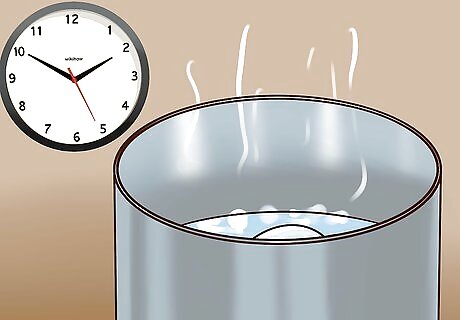
Maintain the temperature for three to five minutes. With the water temperature remaining constant at 60 degrees Celsius, continue heating large eggs for a full three minutes. Extra large eggs should be kept in the hot water for five minutes. Since the temperature of the water should never rise above 61 degrees Celsius (142 degrees Fahrenheit), you will need to continually monitor the temperature during this process. Adjust the temperature settings on your stove as needed to accomplish this task. If you allowed the temperature of the water to rise to 65 degrees Celsius (150 degrees Fahrenheit) or if you are pasteurizing your eggs without the use of a thermometer, you should remove the pan from the heat source before allowing the eggs to sit in the hot water for three to five minutes.
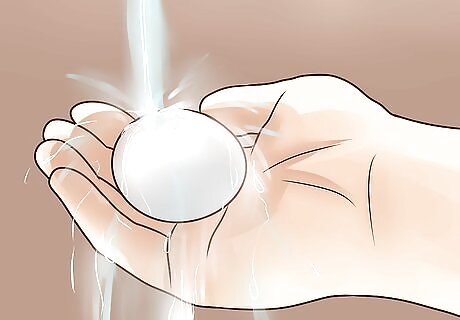
Rinse the eggs with cold water. Carefully fish the eggs out of the water using a slotted spoon and rinse them under cold water until the shell drops down to room temperature or below. Alternatively, you could place the eggs in a bowl of ice water instead of rinsing them under cool, running water. Running water is preferable since sitting water is more likely to develop bacteria, but either option will technically work. Rinsing the eggs with cold water quickly drops the internal temperature of the egg, thereby preventing that temperature from continuing to rise or cook the egg.

Store the eggs in your refrigerator. The eggs should be pasteurized at this point. You can use them right away or continue storing them in your refrigerator for another week or so.
Pasteurizing Eggs After Opening
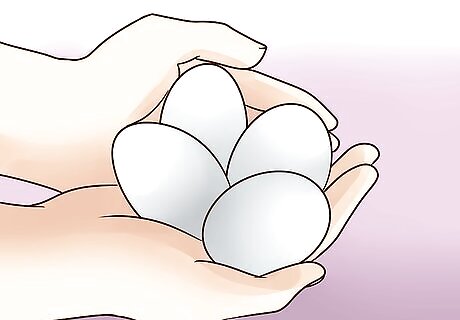
Use fresh eggs. The eggs should be as fresh as possible and free of cracks. Make sure that the eggs are also clean. The use of room temperature eggs is not quite as important with this method since the egg white and/or yolk will be exposed to the heat more directly, but room temperature eggs are still slightly preferable with this method than cold eggs.
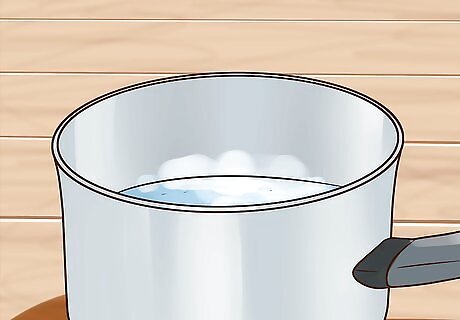
Boil water in a large saucepan. Fill a large saucepan one-third to one-half full with water and set it on your stove over high heat. Allow it to reach a steady simmer and a steady steam before turning off the heat. Continue on with the following step as you wait for the water to heat up. You will also need a second stainless steel bowl that fits comfortably inside this large saucepan of water. The sides of your bowl need to be tall enough to prevent water from the outer pan from splashing inside. Do not place this bowl inside the water just yet, however.
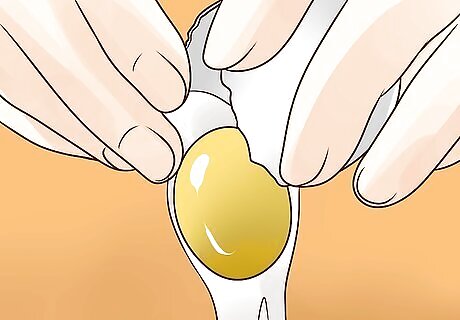
Break open the eggs. Crack your eggs and let the yolk and/or white fall directly into your second stainless steel bowl. With this method, you can pasteurize both the egg white and egg yolk at the same time. If you only need the yolk or the white, though, you can separate the eggs before dropping the portion you need into the bowl. Discard the unneeded portion by dumping it down the drain of your kitchen sink.
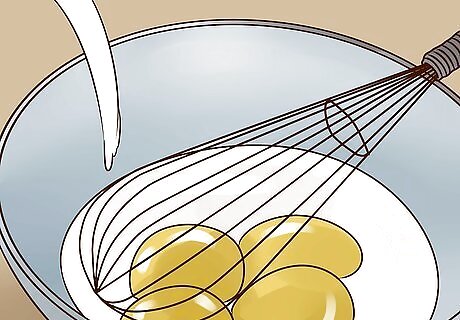
Whisk in a little liquid. Combine the raw egg with a little liquid, using 30 ml (2 Tbsp) of liquid for each complete egg, egg white, or egg yolk. Whisk the ingredients together thoroughly until the egg starts to look foamy. You can use any liquid called for within the recipe, including water, lemon juice, milk, or flavorings. Make sure that you do not add both lemon juice and milk at the same time, though, since the lemon juice (or any acidic liquid, for that matter) will cause the milk to curdle. Curdled milk can ruin the eggs by making them lumpy.

Place the bowl inside the saucepan. Once the water is simmering and the heat has been turned off, place the bottom of the bowl inside your saucepan of water, holding it down using pliers or tongs if necessary. This method uses a double boiler technique to heat and pasteurize the eggs indirectly. You could technically heat the eggs directly by skipping the extra saucepan of water, but doing so increases the risk of accidentally cooking the eggs instead of pasteurizing them. If you do heat the eggs directly, though, make sure that you use the lowest heat setting possible on your stove. Irma S. Rombauer Irma S. Rombauer, Cookbook Author To pasteurize eggs at home, break them into the top part of a double boiler, place over hot water, heat to 140°F, and hold at this temperature for 30 minutes.
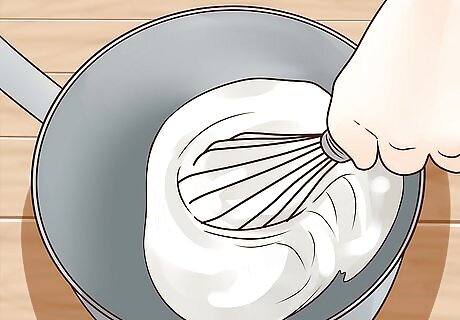
Whisk constantly for until the temperature of the water drops. As soon as you place the bowl of eggs in the hot water, you need to begin whisking the eggs with a fork or wire whisk. Continue whisking for two to three minutes, or until the water drops down to a lukewarm temperature. The constant movement distributes the heat evenly throughout the egg mixture, thereby preventing the egg from cooking in any particular spot or from remaining partially unpasteurized.
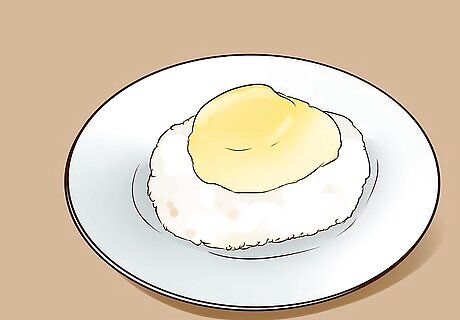
Use the eggs immediately. Let the eggs cool for three minutes or so, then use them as called for in your recipe. You should not attempt to refrigerate or freeze these eggs.

















Comments
0 comment